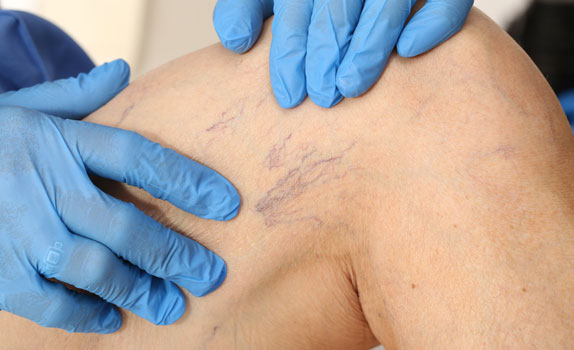Sclerotherapy was developed in the 1920s for the treatment of spider veins (telangiectasias), small purple and red blood vessels. Spider veins are hereditary, and while most commonly found on the thigh or lower leg, can form virtually anywhere on the leg, from the uppermost region of the thigh to the ankle. Occasionally, spider veins will appear on the face. Sclerotherapy has proven to be a very popular nonsurgical cosmetic procedure. statistics.
Technique:
The veins to be treated are marked while the patient is standing. Larger veins are usually treated first. A sclerosing solution is injected into the vein with a micro-needle. The solution causes the vein to turn white (blanch), and then gradually disappear. A typical treatment lasts from 30 minutes to an hour. Injection sclerotherapy can be an excellent alternative to surgery, provided the patient’s venous system is not affected.
Benefits:
- No downtime—patients can immediately resume work and all normal activities. But the patient is advised to refrain from vigorous activities for the first 24 hours.
- Little if any discomfort.
- A safe, time-proven procedure.
Other Considerations:
- The majority of people who have Sclerotherapy performed will see very good improvement with about 80% resolution of their varicose and spider veins. The veins that are treated typically remain closed, however new veins may arise in the same or adjacent area. Clients will often return for varicose or spider treatments once every 2-3 years or later.
- Patients may require purchase measured to fit compression stockings.
- Color changes can occur in the skin where sclerotherapy has been performed.
- In some cases, laser treatments may be an alternative to sclerotherapy.

FAQs
What are spider veins?
Spider veins are most common in women in the age groups 30-50. This has been related to the hormone estrogen and pregnancy. Spider veins look like a network pattern in a circular fashion. These light purple veins usually appear in a lattice pattern and are completely harmless.
Where is the procedure done?
It is usually done in the clinic. It generally does not require any type of anesthesia. The patient is asked to come to the clinic in loose fitting clothing and the spider veins are identified. With a very fine needle, these spider veins are injected with a chemical that will destroy the vein.
What chemicals are used for sclerotherapy?
The spider veins are destroyed by injecting a small amount of a chemical in the vein. The sclerosant is sodium tetradecyl sulphate. The chemical irritates the small vein and causes it to undergo fibrosis and eventually disappear.
Can sclerotherapy be used to treat large varicose veins?
sclerotherapy is generally used for the very small superficial veins next to the skin. Sclerotherapy is also effective for large veins but requires large amounts of the sclerosants . When large veins are treated with sclerotherapy, a stronger solution and a higher volume is required. Following the treatment for larger veins, compression hose stockings are usually recommended to be worn for at least 2 weeks.
How many sclerotherapy treatments are required?
It varies from individual to individual but typically 2-4 treatments are required for the best results. In patients with milder cases, 1-2 will suffice. The treatments are more when there are more veins or slightly larger veins.
Do I have to limit any activity after the treatment?
Walking is highly recommended soon after the procedure. But any high activity sports should be avoided for the first 2-3 days.
Great skin doesn't happen by chance, it happens by appointment.
Hurry, your new skin is waiting. Schedule an appoinment for your initial consult today.